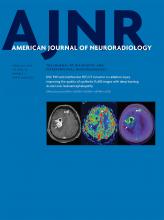Research ArticleFunctional
Open Access
Resting-State Functional Connectivity of the Middle Frontal Gyrus Can Predict Language Lateralization in Patients with Brain Tumors
S. Gohel, M.E. Laino, G. Rajeev-Kumar, M. Jenabi, K. Peck, V. Hatzoglou, V. Tabar, A.I. Holodny and B. Vachha
American Journal of Neuroradiology February 2019, 40 (2) 319-325; DOI: https://doi.org/10.3174/ajnr.A5932
S. Gohel
aFrom the Department of Health Informatics (S.G.), Rutgers University School of Health Professions, Newark, New Jersey
M.E. Laino
bDepartments of Radiology (M.E.L., M.J., K.P., V.H., A.I.H., B.V.)
eDepartment of Radiology (M.E.L.), Catholic University of the Sacred Heart, Rome, Italy
G. Rajeev-Kumar
fIcahn School of Medicine at Mount Sinai (G.R.-K.), New York, New York.
M. Jenabi
bDepartments of Radiology (M.E.L., M.J., K.P., V.H., A.I.H., B.V.)
K. Peck
bDepartments of Radiology (M.E.L., M.J., K.P., V.H., A.I.H., B.V.)
cMedical Physics (K.P.)
V. Hatzoglou
bDepartments of Radiology (M.E.L., M.J., K.P., V.H., A.I.H., B.V.)
V. Tabar
dNeurosurgery (V.T.), Memorial Sloan Kettering Cancer Center, New York, New York
A.I. Holodny
bDepartments of Radiology (M.E.L., M.J., K.P., V.H., A.I.H., B.V.)
B. Vachha
bDepartments of Radiology (M.E.L., M.J., K.P., V.H., A.I.H., B.V.)

References
- 1.↵
- 2.↵
- Desmond JE,
- Sum JM,
- Wagner AD, et al
- 3.↵
- Dym RJ,
- Burns J,
- Freeman K, et al
- 4.↵
- Lehéricy S,
- Cohen L,
- Bazin B, et al
- 5.↵
- Tie Y,
- Rigolo L,
- Norton IH, et al
- 6.↵
- Frost JA,
- Binder JR,
- Springer JA, et al
- 7.↵
- Szaflarski JP,
- Binder JR,
- Possing ET, et al
- 8.↵
- Ulmer JL,
- Hacein-Bey L,
- Mathews VP, et al
- 9.↵
- 10.↵
- Sanai N,
- Mirzadeh Z,
- Berger MS
- 11.↵
- Brown S,
- Martinez MJ,
- Parsons LM
- 12.↵
- 13.↵
- Abrahams S,
- Goldstein LH,
- Simmons A, et al
- 14.↵
- Leung HC,
- Gore JC,
- Goldman-Rakic PS
- 15.↵
- 16.↵
- 17.↵
- 18.↵
- 19.↵
- 20.↵
- Roux FE,
- Boulanouar K,
- Lotterie JA, et al
- 21.↵
- Kamada K,
- Sawamura Y,
- Takeuchi F, et al
- 22.↵
- 23.↵
- 24.↵
- 25.↵
- 26.↵
- Seghier ML
- 27.↵
- Deblaere K,
- Boon PA,
- Vandemaele P, et al
- 28.↵
- Springer JA,
- Binder JR,
- Hammeke TA, et al
- 29.↵
- Rogalski E,
- Cobia D,
- Harrison TM, et al
- 30.↵
- Fertonani A,
- Rosini S,
- Cotelli M, et al
- 31.↵
- Grossman M,
- Cooke A,
- DeVita C, et al
- 32.↵
- Acheson DJ,
- MacDonald MC
- 33.↵
- Baddeley A
- 34.↵
- 35.↵
- 36.↵
- 37.↵
- 38.↵
- Zhang D,
- Johnston JM,
- Fox MD, et al
- 39.↵
- 40.↵
- 41.↵
- Shimony JS,
- Zhang D,
- Johnston JM, et al
- 42.↵
- 43.↵
- Holodny AI,
- Schulder M,
- Liu WC, et al
- 44.↵
- Schreiber A,
- Hubbe U,
- Ziyeh S, et al
- 45.↵
- Partovi S,
- Jacobi B,
- Rapps N, et al
In this issue
American Journal of Neuroradiology
Vol. 40, Issue 2
1 Feb 2019
Advertisement
S. Gohel, M.E. Laino, G. Rajeev-Kumar, M. Jenabi, K. Peck, V. Hatzoglou, V. Tabar, A.I. Holodny, B. Vachha
Resting-State Functional Connectivity of the Middle Frontal Gyrus Can Predict Language Lateralization in Patients with Brain Tumors
American Journal of Neuroradiology Feb 2019, 40 (2) 319-325; DOI: 10.3174/ajnr.A5932
0 Responses
Resting-State Functional Connectivity of the Middle Frontal Gyrus Can Predict Language Lateralization in Patients with Brain Tumors
S. Gohel, M.E. Laino, G. Rajeev-Kumar, M. Jenabi, K. Peck, V. Hatzoglou, V. Tabar, A.I. Holodny, B. Vachha
American Journal of Neuroradiology Feb 2019, 40 (2) 319-325; DOI: 10.3174/ajnr.A5932
Jump to section
Related Articles
- No related articles found.
Cited By...
- Pseudo-Resting-State Functional MRI Derived from Dynamic Susceptibility Contrast Perfusion MRI Can Predict Cognitive Impairment in Glioma
- Resting-State Functional MRI for Determining Language Lateralization in Children with Drug-Resistant Epilepsy
- Glioma-Induced Disruption of Resting-State Functional Connectivity and Amplitude of Low-Frequency Fluctuations in the Salience Network
- Developing fMRI protocol for clinical use Comparison of 6 Arabic paradigms for brain language mapping in native Arabic speakers
This article has not yet been cited by articles in journals that are participating in Crossref Cited-by Linking.
More in this TOC Section
Similar Articles
Advertisement











